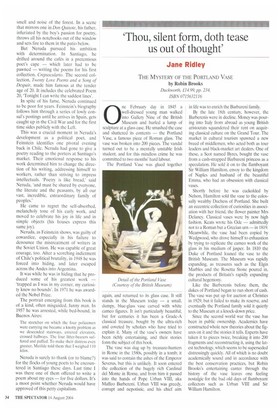'Thou, silent form, doth tease us out of thought'
Jane Ridley
THE MYSTERY OF THE PORTLAND VASE by Robin Brooks Duckworth, .f14.99, pp. 234, ISBN 0715632116 le February day in 1845 a well-dressed young man walked into Gallery Nine of the British Museum and hurled a lump of sculpture at a glass case. He smashed the case and shattered its contents — the Portland Vase, a famous piece of Roman glass. The vase was broken into 200 pieces. The vandal turned out to be a mentally unstable Irish student, and for this mindless crime he was committed to two months' hard labour.
The Portland Vase was glued together again, and returned to its glass case. It still stands in the Museum today — a small, dumpy, blue-glass vase carved with white cameo figures. It isn't particularly beautiful, but for centuries it has been a Grade-A classical treasure, bought by the ultra-rich and coveted by scholars who have tried to explain it. Many of the vase's owners have been richly entertaining, and their stories form the subject of this book.
The vase was dug up by treasure-hunters in Rome in the 1580s, possibly in a tomb; it was said to contain the ashes of the Emperor Severus, but this is unlikely. It soon entered the collection of the hugely rich Cardinal del Monte in Rome, and from him it passed into the hands of Pope Urban VIII, aka Maffeo Barbereni. Urban VIII was greedy, corrupt and nepotistic, and his chief aim in life was to enrich the Barbareni family.
By the late 18th century, however, the Barberenis were in decline. Money was pouring into Italy from abroad as young British aristocrats squandered their rent on acquiring classical culture on the Grand Tour. The market in cultural tourism spawned a new breed of middlemen, who acted both as tour leaders and black-market art dealers. One of these, a Scot named Byres, bought the vase from a cash-strapped Barbareni princess as a speculation. He sold it on to the flamboyant Sir William Hamilton, envoy to the kingdom of Naples and husband of the beautiful Emma, who had an obsession with classical vases.
Shortly before he was cuckolded by Nelson, Hamilton sold the vase to the colossally wealthy Duchess of Portland. She built an eccentric collection of curiosities in association with her friend, the flower painter Mrs Delaney. Classical vases were by now high fashion. Keats wrote his Ode — admittedly not to a Roman but a Grecian urn — in 1819. Meanwhile, the vase had been copied by Wedgwood, who drove himself to exhaustion by trying to replicate the cameo work of the glass in his medium of jasper. In 1810 the Duke of Portland loaned the vase to the British Museum. The Museum was rapidly expanding, as treasures such as the Elgin Marbles and the Rosetta Stone poured in, the products of Britain's rapidly expanding cultural hegemony.
Like the Barberenis before them, the dukes of Portland began to run short of cash. The vase was put up for auction at Christies in 1929, but it failed to make its reserve, and eventually the Portland family sold it quietly to the Museum at a knock-down price.
Since the second world war the vase has been in public ownership. Academics have constructed whole new theories about the figures on it and the stories it tells. Experts have taken it to pieces twice, breaking it into 200 fragments and reconstructing it, using the latest technology, which seems to be superseded distressingly quickly. All of which is no doubt academically sound and in accordance with the best conservation practices, but Robin Brooks's entertaining canter through the history of the vase leaves one feeling nostalgic for the bad old days of flamboyant collectors such as Urban VIII and Sir William Hamilton.


























































 Previous page
Previous page